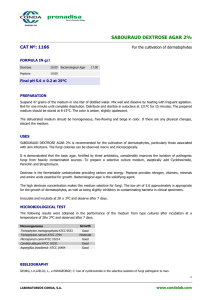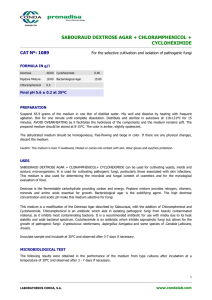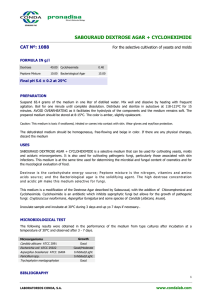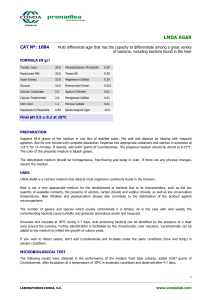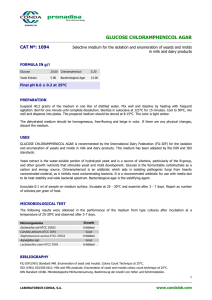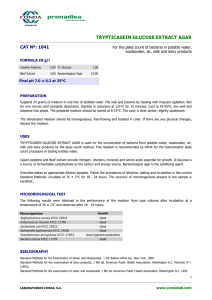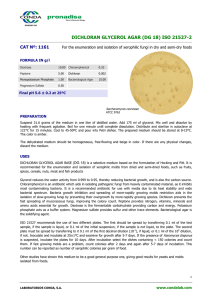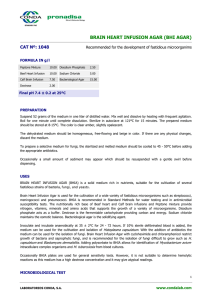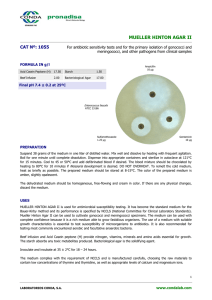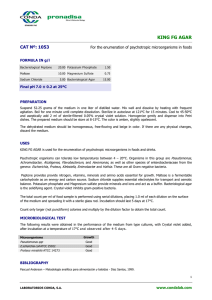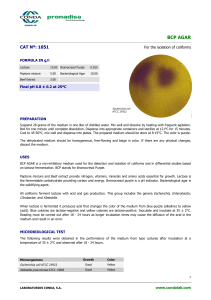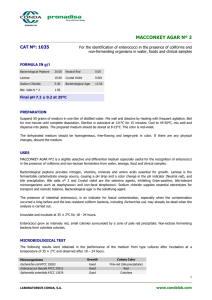MYCOBIOTIC AGAR (FUNGAL SELECTIVE AGAR) CAT Nº: 1072
advertisement
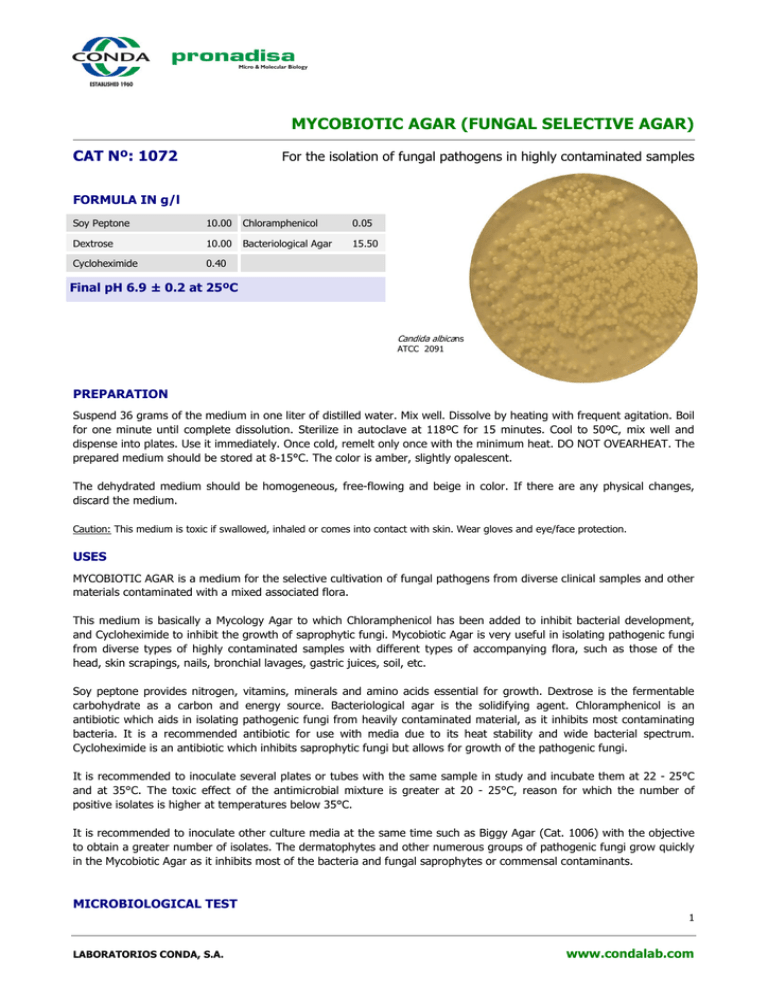
MYCOBIOTIC AGAR (FUNGAL SELECTIVE AGAR) CAT Nº: 1072 For the isolation of fungal pathogens in highly contaminated samples FORMULA IN g/l Soy Peptone 10.00 Chloramphenicol 0.05 Dextrose 10.00 Bacteriological Agar 15.50 Cycloheximide 0.40 Final pH 6.9 ± 0.2 at 25ºC Candida albicans ATCC 2091 PREPARATION Suspend 36 grams of the medium in one liter of distilled water. Mix well. Dissolve by heating with frequent agitation. Boil for one minute until complete dissolution. Sterilize in autoclave at 118ºC for 15 minutes. Cool to 50ºC, mix well and dispense into plates. Use it immediately. Once cold, remelt only once with the minimum heat. DO NOT OVEARHEAT. The prepared medium should be stored at 8-15°C. The color is amber, slightly opalescent. The dehydrated medium should be homogeneous, free-flowing and beige in color. If there are any physical changes, discard the medium. Caution: This medium is toxic if swallowed, inhaled or comes into contact with skin. Wear gloves and eye/face protection. USES MYCOBIOTIC AGAR is a medium for the selective cultivation of fungal pathogens from diverse clinical samples and other materials contaminated with a mixed associated flora. This medium is basically a Mycology Agar to which Chloramphenicol has been added to inhibit bacterial development, and Cycloheximide to inhibit the growth of saprophytic fungi. Mycobiotic Agar is very useful in isolating pathogenic fungi from diverse types of highly contaminated samples with different types of accompanying flora, such as those of the head, skin scrapings, nails, bronchial lavages, gastric juices, soil, etc. Soy peptone provides nitrogen, vitamins, minerals and amino acids essential for growth. Dextrose is the fermentable carbohydrate as a carbon and energy source. Bacteriological agar is the solidifying agent. Chloramphenicol is an antibiotic which aids in isolating pathogenic fungi from heavily contaminated material, as it inhibits most contaminating bacteria. It is a recommended antibiotic for use with media due to its heat stability and wide bacterial spectrum. Cycloheximide is an antibiotic which inhibits saprophytic fungi but allows for growth of the pathogenic fungi. It is recommended to inoculate several plates or tubes with the same sample in study and incubate them at 22 - 25°C and at 35°C. The toxic effect of the antimicrobial mixture is greater at 20 - 25°C, reason for which the number of positive isolates is higher at temperatures below 35°C. It is recommended to inoculate other culture media at the same time such as Biggy Agar (Cat. 1006) with the objective to obtain a greater number of isolates. The dermatophytes and other numerous groups of pathogenic fungi grow quickly in the Mycobiotic Agar as it inhibits most of the bacteria and fungal saprophytes or commensal contaminants. MICROBIOLOGICAL TEST 1 LABORATORIOS CONDA, S.A. www.condalab.com The following results were obtained in the performance of the medium from type cultures after incubation at a temperature of 30°C and observed after 3 - 7 days. Microorganisms Growth Escherichia coli ATCC 25922 Staphylococcus aureus ATCC 25923 Trichophyton mentagrophytes ATCC 9533 Trichophyton rubrum ATCC 28188 Candida albicans ATCC 2091 Aspergillus brasiliensis ATCC 16404 Penicillium spp. Inhibited Inhibited Good Good Good Inhibited Inhibited BIBLIOGRAPHY Dean and Halley, Public Health Reports, 77:61. 1972. Hupper and Walker, A.J. Clin. Path. 29:291. 1958. McDonough Ajello, Georg, and Brinkman J. Lab. and Clin. Med. 55:116. 1960. STORAGE 25ºC Once opened keep powdered medium closed to avoid hydration. 2ºC 2 LABORATORIOS CONDA, S.A. www.condalab.com
